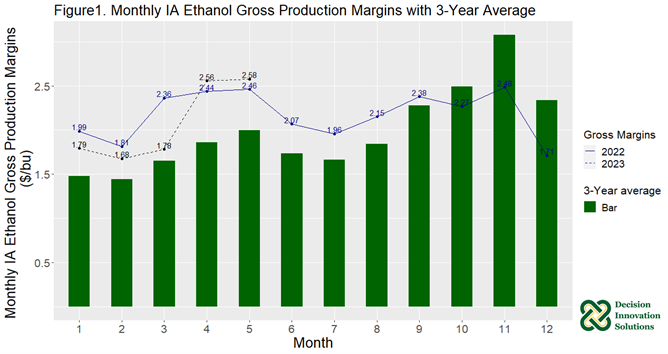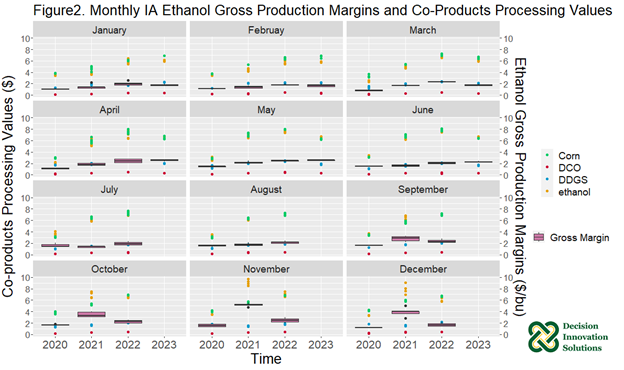We’ve conducted this series report over the years. It started with abnormal weather events (serious flooding in the main corn planted states) in 2019, in which we discussed how the delays in corn planting process influenced the ethanol gross production margin (GPM) values. In 2020, there were unique and difficult situations due to the COVID-19 pandemic. In the last two blogs, we discussed how the GPM behaved since the pandemic started in 2020 March up to June 2021. After recovering from the pandemic, ethanol value reached the highest level since 2014. In this article, the focus is on the behavior of GPM from June 2022 to June 2023.
The gross production margin, in the ethanol industry, commonly represents the difference between the combined sales values of ethanol, distiller’s dried grains (DDGS) and distillers corn oil (DCO), and the price of corn. All data came from National Weekly Grain Co-Products Report from the USDA AMS website. The latest data was updated on June 16th, 2023 (when the blog is written on June 23rd, 2023). GPM calculation shows the calculated relationship between values of ethanol and ethanol co-products and the cost of corn in ethanol production.
Figure 1 shows the monthly average Iowa ethanol GPM for 2022 and 2023, in solid line and dashed line, respectively. Also, it shows the three-year average (2020 to 2022) Iowa ethanol GPM for each month. Almost all monthly GPMs in 2022 and in the first half year of 2023 have been above the three-year average values, except for the last three months. For these months, the very high gross margins in the last quarter in 2021 have pushed up the 3-year average.
Within the study time frame, average corn prices were $7.08/bu and $6.56/bu for 2022 and 2023, respectively, which were higher than the correspond prices in 2020 and 2021, which were $3.47/bu and $5.86/bu, respectively. Corn prices increased about 2.7% from 2021 to 2022 and decreased 7.35% from 2022 to 2023, which is the first year with a decrease in the corn price trend since 2017.
Calculated GPMs showed extremely high values in the last quarter in 2021, with an average GPM of $4.18/Bu, which is two times higher than the average GPM in 2020. In early 2022, the GPM fell back to $2.17/bu, and continuously dropping down to $2.09/bu in 2023.
Average DCO values were $0.43/bu and $0.35/bu for the second half year of 2022 and first half year of 2023, respectively, reflecting decreases of about 6.5% and 23.9%, compared to the average DCO value ($0.46/bu) during the first half year of 2022. Plus, ethanol values decreased about 0.8% and 8.3% during the same period. Thus, the GPMs dropped from $2.19/bu (average GPM from first half year of 2022) to $2.16/bu and $2.09/bu in the second half year of 2022 and first half year of 2023, respectively.

In Figure 2, the scatter points represent the weekly sales values (raw data from AMS weekly report) for corn, ethanol, DDGS, and DCO using green, yellow, blue, and red color, respectively. The boxplots in pink color represent the range of weekly IA ethanol GPMs.
Applying ANOVA and the Tukey-HSD test on the study period, i.e., January 2020 to June 2023, we found that:
For the first half-year, in general (combine 6-month GPM values), the GPM values in 2021 are significantly higher than all other years, and 2020 values were significantly lower than all other years; and there is no significant difference between the GPM values in 2022 and 2023.
For the second half-year, in general (combined 6-month GPM values), the GPM value in 2021 is significantly higher than other years, and 2022 is significantly higher than 2020.

Applying the Pearson correlation test, we found that within the study period, corn price has had a strong significant negative effect in all months. The value of DDGs has had significant effects in almost all the months, but with mixed signs. It appears that if one month sale value of DDGs had significant positive effect on GPMs, then the next month the sale value of DDGs had significant negative effect on GPMs.
The sales value of DCO had significant positive effect on GPMs in the month of August and October, while it had significant negative effect in the month of November through February. Then after March 2023, the sign of correlation become positive, but has not found any significance. The sale value of ethanol has had a strong significant positive effect on GPM, in almost all months during the study period, except March and April 2023.
In summary, the ethanol price (ethanol sales value) is still the dominant variable throughout the study period, and has a strong significant, positive effect on GPM values. A similar conclusion was found in previous analysis — that the ethanol price became the dominant variable since the second half year of 2020. This was because fuel ethanol production is slowly returning to normal but is still relatively low compared with 2018 and 2019 level. Another observation is that fuel ethanol production in 2022 was like 2016’s level. However, even though fuel ethanol production and ethanol price are getting “back to normal”, the relationship among ethanol price, DDGs price, DCO prices, corn prices and GPMs may change in the future in response to changes in biofuels policy.

